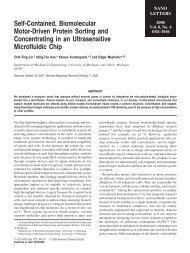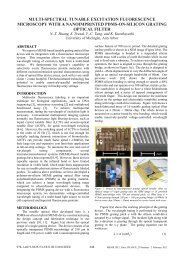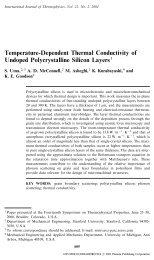Miniaturisation for chemistry, physics, biology, materials science and ...
Miniaturisation for chemistry, physics, biology, materials science and ...
Miniaturisation for chemistry, physics, biology, materials science and ...
Create successful ePaper yourself
Turn your PDF publications into a flip-book with our unique Google optimized e-Paper software.
Downloaded by University of Michigan Library on 22 August 2012<br />
Published on 15 June 2012 on http://pubs.rsc.org | doi:10.1039/C2LC40509A<br />
insight into the mechanism of life through genomics. Modern life<br />
<strong>science</strong>s still see further challenges towards translating the<br />
discoveries in genomics into a full underst<strong>and</strong>ing of genetically<strong>and</strong><br />
environmentally-affected human traits <strong>and</strong> disease developments.<br />
Statistical noise in genomic data often makes it difficult to<br />
elucidate the cause of underscore biological effects. 11,12 Modern<br />
<strong>biology</strong> has come to recognize that heterogeneity in non-genetic<br />
cellular phenotypes is one of the key factors governing core<br />
processes that occur at the cellular level, including proliferation,<br />
stimulus response, carcinogenesis, <strong>and</strong> drug resistance. Many<br />
diseases, including cancer, originate in a single or a few cells<br />
showing abnormal phenotypes. Early detection of the onset of a<br />
cellular phenotype abnormality would allow better disease<br />
diagnosis <strong>and</strong> treatment. Optofluidics is an exciting research field,<br />
particularly during the current transitional period with biological<br />
research. Optofluidic technology holds great promise to serve as a<br />
powerful tool to enable single cell-level phenotype characterization.<br />
We strongly believe that the importance of this field will be<br />
more pronounced than ever as cellular phenotyping research<br />
manifests its need <strong>for</strong> advanced optical detection tools.<br />
Optofluidic systems realize efficient, fast, skill-free on-chip<br />
operations in manipulation <strong>and</strong> h<strong>and</strong>ling of individual cells <strong>and</strong><br />
assay reagent loading while securing optical access to on-chip<br />
samples. Here, we propose to extend the definition of ‘‘optofluidics’’<br />
to broader systems capable of advancing microfluidics<br />
with optics. Future research can focus on advancing microfluidic<br />
cellular phenotyping techniques to the point that they become<br />
equipped with unprecedented levels of throughput. 76–81,97<br />
Coupled with a massively parallel microfluidic single-cell<br />
manipulation plat<strong>for</strong>m, optical technologies leading to higher<br />
sensitivity, accuracy, <strong>and</strong> signal h<strong>and</strong>ling capability would<br />
generate a huge number of phenotype datasets <strong>and</strong> provide a<br />
higher degree of in<strong>for</strong>mation. In the context of enabling cellular<br />
phenotyping assays, the ef<strong>for</strong>t to achieve monolithic optics-fluid<br />
integration perhaps does not find a great value. Here, an<br />
emphasis should be placed in per<strong>for</strong>ming sophisticated fluidic<br />
actuation <strong>for</strong> sample loading, transporting, <strong>and</strong> sorting with<br />
highly sensitive, selective optical detection done by using off-chip<br />
optical instruments. As found with current studies on SERS <strong>and</strong><br />
LSPR, 34,37,38 signal enhancement by nanostructures integrated in<br />
a microfluidic channel will continue to be an important research<br />
topic. Along with this direction, researchers also need to note<br />
that optofluidic technology has the great potential to integrate<br />
multiple optical detection modalities (e.g., fluorescence + SERS,<br />
fluorescence + SPR, fluorescence + interferometry) in a common<br />
microfluidic plat<strong>for</strong>m. Such a multi-modality detection approach<br />
may synergistically enable multi-parametric analyses with high<br />
sensitivity <strong>and</strong> specificity. Multi-parametric analysis devices are<br />
‘‘must-have’’ tools <strong>for</strong> data-intensive genotype-phenotype mapping<br />
assays.<br />
Of course, the research community can be directed towards<br />
another important direction, which focuses on developing fully<br />
integrated st<strong>and</strong>alone micro-analytical devices <strong>for</strong> POC applications.<br />
We find a majority of the reviewed studies still requires the<br />
use of large, expensive, <strong>and</strong> sophisticated off-chip lasers,<br />
detectors, <strong>and</strong> spectrometers. As seen in semiconductor <strong>and</strong><br />
microelectromechanical systems (MEMS) industry, system integration<br />
<strong>and</strong> packaging are a critically important research area to<br />
enable future mass production <strong>and</strong> commercialization. We<br />
expect to see this research field evolving to provide innovative<br />
monolithic optics-fluid integration schemes. We expect that<br />
growth towards this research direction, shown by the recent<br />
demonstration of fluidic channel-on-a-CCD detector chip, 98–100<br />
spectrometer-on-a-fluidic chip, 29 <strong>and</strong> flow cytometer-on-a-cell<br />
phone 75 devices, will open ways <strong>for</strong> development of st<strong>and</strong>alone<br />
cellular phenotyping microchips <strong>for</strong> global health care.<br />
Acknowledgements<br />
The authors acknowledge support by the National Science<br />
Foundation under grants CBET-0966723 (K.K.) <strong>and</strong> ECCS-<br />
0601237 (K.K.); the National Institute of Health under grant<br />
R01-CA-142750-01 (K.K.); the Coulter Foundation (K.K.);<br />
Taiwan National Health Research Institutes (NHRI) Career<br />
Development Grant (CDG) under grant NHRI-EX101-10021EC<br />
(Y.-C.T.); Taiwan National Science Council (NSC) under grant<br />
100-2221-E-001-002(Y.-C.T.); the University of Michigan<br />
Rackham Predoctoral Fellowship (N.-T.H.); the China PS<br />
Foundation under Grant No. 20110490672 <strong>and</strong> the FP7<br />
European project 247641 (W.J.Z.); the National Natural<br />
Science Foundation of China under Grant No. 51071045 <strong>and</strong><br />
the Program <strong>for</strong> New Century Excellent Talents in University of<br />
Ministry of Education of China under Grant No. NCET-11-<br />
0096 (T.Q.); Hong Kong Research Grant Council General<br />
Research Funds No. 112510 <strong>and</strong> City University of Hong Kong<br />
Applied Research Grant No. 9667066 (P.K.C.).<br />
References<br />
1 J. Lamb, E. D. Craw<strong>for</strong>d, D. Peck, J. W. Modell, I. C. Blat, M. J.<br />
Wrobel, J. Lerner, J. P. Brunet, A. Subramanian, K. N. Ross, M.<br />
Reich, H. Hieronymus, G. Wei, S. A. Armstrong, S. J. Haggarty,<br />
P. A. Clemons, R. Wei, S. A. Carr, E. S. L<strong>and</strong>er <strong>and</strong> T. R. Golub,<br />
Science, 2006, 313, 1929–1935.<br />
2 L. A. Loeb, Nat. Rev. Cancer, 2011, 11, 450–457.<br />
3 A. S. Rodrigues, J. Dinis, M. Gromicho, C. Martins, A. Laires <strong>and</strong><br />
J. Rueff, Curr. Pharm. Biotechnol., 2012, 13, 651–673.<br />
4 M. Martinez-Rivera <strong>and</strong> Z. H. Siddik, Biochem. Pharmacol., 2012,<br />
83, 1049–1062.<br />
5 A. K. Abbas, K. M. Murphy <strong>and</strong> A. Sher, Nature, 1996, 383, 787–793.<br />
6 K. C. Wood <strong>and</strong> D. N. Granger, Clin. Exp. Pharmacol. Physiol.,<br />
2007, 34, 926–932.<br />
7 F. Patella <strong>and</strong> G. Rainaldi, Cell. Mol. Life Sci., 2012, 69, 1049–1065.<br />
8 H. Clevers, Nat. Genet., 2005, 37, 1027–1028.<br />
9 P. L. Gourley, J. Phys. D: Appl. Phys., 2003, 36, R228–R239.<br />
10 X. J. Liang, A. Q. Liu, C. S. Lim, T. C. Ayi <strong>and</strong> P. H. Yap, Sens.<br />
Actuators, A, 2007, 133, 349–354.<br />
11 B. R. Bochner, Nat. Rev. Genet., 2003, 4, 309–314.<br />
12 E. T. Dermitzakis, Nature Reviews Genetics, 2012, 13, 215–220.<br />
13 D. Psaltis, S. R. Quake <strong>and</strong> C. Yang, Nature, 2006, 442, 381–386.<br />
14 H. Schmidt <strong>and</strong> A. R. Hawkins, Nat. Photonics, 2011, 5, 598–604.<br />
15 F. B. Myers <strong>and</strong> L. P. Lee, Lab Chip, 2008, 8, 2015–2031.<br />
16 X. D. Fan <strong>and</strong> I. M. White, Nat. Photonics, 2011, 5, 591–597.<br />
17 M.-A. Mycek, B. W. Pogue, H<strong>and</strong>book of Biomedical Fluorescence,<br />
Marcel Dekker, Inc, New York, 2003.<br />
18 B. M. Sauer, J. Hofkens, J. Enderlein, H<strong>and</strong>book of Fluorescence <strong>and</strong><br />
Imaging: From Ensemble to Single Molecules, Wiley-VCH,<br />
Weinheim, 2011.<br />
19 J. Lippincott-Schwartz <strong>and</strong> G. H. Patterson, Science, 2003, 300,<br />
87–91.<br />
20 B. Zhu, H. Jia, X. Zhang, Y. Chen, H. Liu <strong>and</strong> W. Tan, Anal.<br />
Bioanal. Chem., 2010, 397, 1245–1250.<br />
21 R. A. Seder, P. A. Darrah <strong>and</strong> M. Roederer, Nat. Rev. Immunol.,<br />
2008, 8, 247–258.<br />
22 J. S. Boomer, K. To, K. C. Chang, O. Takasu, D. F. Osborne, A. H.<br />
Walton, T. L. Bricker <strong>and</strong> S. D. Jarman, JAMA, J. Am. Med.<br />
Assoc., 2011, 306, 2594–2605.<br />
This journal is ß The Royal Society of Chemistry 2012 Lab Chip, 2012, 12, 3552–3565 | 3563





